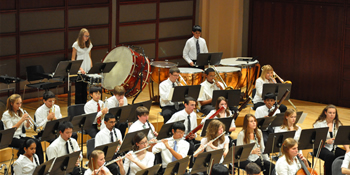The five East Carolina University School of Music faculty members who make up the Coastal Winds Quintet took on a challenging program of wind music and scored well in all areas. As explained by Christopher Ulffers,* bassoonist, the “big three” for any wind quintet would be works by Barber, Hindemith, and Nielsen, and the concert at A.J. Fletcher Recital Hall included two of them: Barber and Hindemith. Also on the program were pieces by Mozart (in honor of his 258th birthday) and 20th century Danish composer Flemming Weis. Along with Ulffers, the Coastal Winds players are Christine Gustafson, flute, Bo Newsome, oboe, Douglas Monroe, clarinet, and Mary Burroughs, horn. Each member had moments to shine, and the blend of instruments was quite lovely.
Samuel Barber’s Summer Music, Op. 31, is not to be confused with his Knoxville: Summer of 1915, although one might detect a few phrases here and there that recall elements of the earlier (Op. 24) work. This piece, written in 1956, conveys mainly a minor-key impression, opening with a somber nine-note figure led by horn and bassoon, but there are also moments of lightness, almost dance-like, that provide nice contrasts. The composer gives each player several spotlights, as well as some nice duet and trio sections. Interesting threads throughout were frequent ostinato-like two-note repetitions played by Burroughs. Newsome’s lead oboe line early in the piece was beautifully played. The quintet closes almost unexpectedly, with a quick and lively statement.
Kleine Kammermusik für fünf Bläser (“Small Chamber Music for Winds”), Op. 24, No. 2, written by Paul Hindemith in 1922, mixes a variety of moods and instrumentation, from the light-hearted opening “Lustig” (“Funny”) to the more flowing “Ruhig und einfach” (“Quiet and Easy”). The five movements are relatively short but still allow for some excellent solo passages as well as pairs and trios. The first movement might be named “funny,” but it actually resembles more closely the impression of downtown street traffic than something humorous. The instruments never were harsh – Monroe’s clarinet was elegantly mellow, and Gustafson’s flute was bright without being shrill – and they complemented each other quite well throughout the piece. Ulffers provided occasional support similar to that of a continuo, but he mainly gave a rich bass harmony as well as a solid foundation for the other instruments. The second waltz movement, with its offbeat sort of melody line, included sprightly phrases from Gustafson on piccolo, and was way too short; the third “Ruhig und einfach” movement was more sensuous, with an appealing blend of all five instruments. Newsome’s legato oboe line, played above the flute, clarinet, and horn in a march-like accompaniment, was quite nice. The final two movements were lively, urgent, at times forceful but without being harsh, and received excellent readings by all players.
The program began with Without serious intentions by Danish composer Flemming Weis. The piece is pleasing, from its jovial opening through its languid second section and up-tempo later sections. Monroe provided especially fine clarinet lines midway through, and there were some nice duet and trio sections, especially by Gustafson and Newsome and by Gustafson, Monroe, and Ulffers. At one point, a phrase for bassoon was vaguely reminiscent of the five-note musical signal featured in Close Encounters of the Third Kind.
The program also included Mozart’s Divertimento in F, No. 13, KV 253, at once a simple and gorgeous composition, despite its being a sort of “Tafelmusik” accompaniment to a meal. The opening theme and variations offered opportunities to shine for individual players, as well as smaller groupings within the quintet, and the performers did not disappoint. The second minuet section created visions of dancers in their 18th century finery, with a particularly nice flute lead by Gustafson, and the third allegro assai movement was a lively, even jolly, section, in which an emphatic opening line led by Burroughs’ horn contrasted nicely with more subtle scoring for the instruments. As interesting as the Barber and Hindemith quintets are, the Mozart wind quintet showed the more elegant sound that a winds-only ensemble can produce, if elegance is what the listener wants.
*Congratulations are due Ulffers, recently appointed Director of the School of Music. For details, click here.












